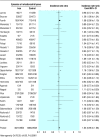Effect of iron supplementation on incidence of infectious illness in children: systematic review
- PMID: 12433763
- PMCID: PMC133452
- DOI: 10.1136/bmj.325.7373.1142
Effect of iron supplementation on incidence of infectious illness in children: systematic review
Abstract
Objective: To evaluate the effect of iron supplementation on the incidence of infections in children.
Design: Systematic review of randomised controlled trials.
Data sources: 28 randomised controlled trials (six unpublished and 22 published) on 7892 children.
Interventions: Oral or parenteral iron supplementation or fortified formula milk or cereals.
Outcomes: Incidence of all recorded infectious illnesses, and individual illnesses, including respiratory tract infection, diarrhoea, malaria, other infections, and prevalence of positive smear results for malaria.
Results: The pooled estimate (random effects model) of the incidence rate ratio (iron v placebo) was 1.02 (95% confidence interval 0.96 to 1.08, P=0.54; P<0.0001 for heterogeneity). The incidence rate difference (iron minus placebo) for all recorded illnesses was 0.06 episodes/child year (-0.06 to 0.18, P=0.34; P<0.0001 for heterogeneity). However, there was an increase in the risk of developing diarrhoea (incidence rate ratio 1.11, 1.01 to 1.23, P=0.04), but this would not have an overall important on public health (incidence rate difference 0.05 episodes/child year, -0.03 to 0.13; P=0.21). The occurrence of other illnesses and positive results on malaria smears (adjusted for positive smears at baseline) were not significantly affected by iron administration. On meta-regression, the statistical heterogeneity could not be explained by the variables studied.
Conclusion: Iron supplementation has no apparent harmful effect on the overall incidence of infectious illnesses in children, though it slightly increases the risk of developing diarrhoea.
Figures
Comment in
-
Improving iron status in children in poor environments.BMJ. 2002 Nov 16;325(7373):1125. doi: 10.1136/bmj.325.7373.1125. BMJ. 2002. PMID: 12433742 Free PMC article. No abstract available.
-
Effect of iron supplementation on incidence of infectious illness in children: systematic review.J Pediatr. 2003 May;142(5):588. J Pediatr. 2003. PMID: 12776705 No abstract available.
References
-
- United Nations Administrative Committee on Coordination Sub-Committee on Nutrition (ACC/SCN) Fourth report on the world nutrition situation. Geneva: ACC/SCN in collaboration with International Food Policy Research Institute; 2000.
-
- Pollitt E. Iron deficiency anaemia and cognitive function. Ann Rev Nutr. 1993;13:521–537. - PubMed
-
- American Academy of Pediatrics-Committee on Nutrition. Nutritional needs of low-birth-weight infants. Pediatrics. 1985;75:976–986. - PubMed
-
- Hurrell RF. Preventing iron deficiency through food fortification. Nutr Rev. 1997;55:210–222. - PubMed
-
- Kochan I. The role of iron in bacterial infections with special consideration of host-tubercle bacillus interaction. Curr Top Microbiol Immunol. 1973;60:1–30. - PubMed
Publication types
MeSH terms
Substances
LinkOut - more resources
Full Text Sources
Medical



